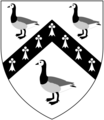English: Arms of Burnell of Cocktree in the parish of South Tawton, Devon:
Argent, a chevron ermines between three burnells proper (Source:
Pole, Sir William (d.1635), Collections Towards a Description of the County of Devon,
Sir John-William de la Pole (ed.), London, 1791, pp.472,508). Burnells are a type of bird (Pole, p.508, re arms of Wyke), generally believed to be Barnacle geese. The blazon per Pole, p.472
barnacles in heraldic language refers to a type of horse bit, which is not intended. Also the tincture
proper is generally used for animal or vegetable charges where the colours are self-evident.
Wikipedia:Roger Wyke (d.1467) of Bindon in the parish
of Axminster, Devon, MP, was a younger son of William Wyke of
Wikipedia:North Wyke in the parish of
South Tawton in Devon, by his wife Katherine Burnell, daughter and heires of John Burnell of Cocktree in the parish of South Tawton. He inherited much of his mothers property and "no doubt for this reason" (Source: Woodger, L.S., biography of
Wyke, Roger (d.c.1467), of Bindon in Axmouth, Devon, published in
History of Parliament: House of Commons 1386-1421, ed. J.S. Roskell, L. Clark, C. Rawcliffe., 1993
[1]) he adopted his maternal
canting arms of Burnell
Argent, a chevron ermines between three burnells proper (where burnells are a type of bird, (see
Pole, Sir William (d.1635), Collections Towards a Description of the County of Devon,
Sir John-William de la Pole (ed.), London, 1791, p.508. Pole, p.472 also blazons the charges as
barnacles proper, p.472, which in heraldry are a type of horse bit made of metal (Pole's work having been saved from fire and Civil War destruction and transcribed by a distant descendant, is unavoidably full of dubious spellings and interpretations, as explained in the preface by his transcriber
Sir John de la Pole, 6th Baronet (d.1799)). The tincture
proper is more suited for use with animal and vegetable charges, whose colours are self-evident. Woodger suggests the charges as
barnacle geese) probably
Barnacle geese (
Hamilton Rogers (d.1913) visited Bindon and described in his
Memorials of the West, Historical and Descriptive, Collected on the Borderland of Somerset, Dorset and Devon, Exeter, 1888, pp.376-7 finding "On the seat of another window near we observed three carved stone shields a bouche, discovered during some repairs, which exhibit the coat-armour of the Wykes : — A chevron ermine, between three birds (barnacle geese), and Wyke impaling Hody — a fesse indented within, bctiocen (?) two barrulets, a mullet for difference, and Hody impaling Wyke",
[2]) in lieu of his paternal arms of Wyck, which continued to be borne by his elder brothers.

